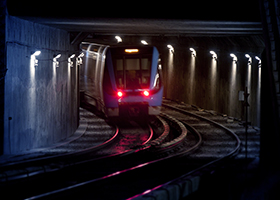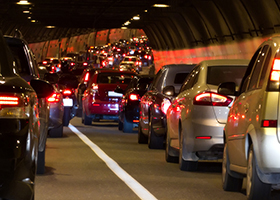A new study from the National Road and Transport Research Institute (VTI) demonstrates that older types of trains produce more particulate emissions in railroad tunnels than do newer ones. Dust binding, improved paving, and reduced studded tyre use could reduce coarse particle levels in road tunnels.

Some trains can be tied to emissions of ultrafine particles. Photo: Thinkstock
High levels of air pollutants are a common problem in both road and railroad tunnels. It is important to reduce these emissions and human exposure to them on station platforms and in vehicles, as such particles pose a health risk.
“We have conducted this study to improve our understanding of the differences between inhalable particles in highway versus railway environments. We have also studied the sources of these particles and mapped the means available for remedying the problems associated with high particle counts”, said VTI researcher Mats Gustafsson.
Condition of trains affects emissions
The results indicate that the environment of the studied railroad tunnel is characterized by peaks in coarse particle concentration. Some trains can be tied to emissions of ultrafine particles. In terms of their content, the particles consist mainly of iron, with lesser amounts of copper, zinc, and other metals.
Comparison with data regarding train passengers and train types indicates that most of the high particle counts can be linked to older RC-type trains. These trains are primarily mechanically braked, and must brake for extended times and distances before stopping at stations. The level of elementary carbon in the air in the railway environment was unexpectedly high, despite the absence of combustion sources. The researchers believe this to be attributable to wear sustained by graphite from the trains’ pantographs.
The main focus of measures to remedy high particle counts in railway tunnels has so far been on preventing exposure by separating the trains from the platforms or on ventilation to remove polluted air. On the other hand, few studies have examined the means available to prevent the emissions themselves.
“Our study demonstrates that it is possible to reduce the particulate emissions by identifying and improving train types as well as individual trains and their characteristics. Technical systems that entail particulate emissions are also present. Furthermore, it is important to monitor the maintenance status of the trains, as well as how they are being driven”, said Gustafsson.
Road tunnels with high levels of ultrafine particles

“The options available to combat coarse particles in road tunnels comprise reduced studded tyre use, better paving, and efficient dust binding and cleaning”. Photo: Thinkstock Photos
Road tunnels are characterized by high levels of ultrafine particles, and by high levels of coarse particles when conditions are dry. Because the traffic in such tunnels is more intense than in railroad tunnels, the particle levels are more consistently high during rush hours.
When conditions are wet, the coarse particles consist mainly of iron and the smaller particles mainly of sulphur. The levels of the mineral elements silicon, potassium, calcium, and iron increase dramatically under dry conditions. Chlorine accounts for a significant share under both wet and dry conditions, which points to a contribution from road salt. The iron is believed to derive from brakes under wet conditions, and from both brakes and road wear under dry conditions.
“The options available to combat coarse particles in road tunnels comprise reduced studded tyre use, better paving, and efficient dust binding and cleaning”, said Gustafsson.
The ultrafine particles that occur in high concentrations derive from vehicle exhaust, and can be addressed by reducing traffic volumes, improving exhaust treatment, and lowering the proportion of heavy traffic.
About the measurements
The measurements were made in Sweden at Arlanda Central, a train station beneath Arlanda Airport, and in the Söderleden Tunnel, a road tunnel in central Stockholm.
VTI Report 917A (in English)
 Contact:
Contact:
Mats Gustafsson
mats.gustafsson@vti.se
VTI, Sweden






Follow us: